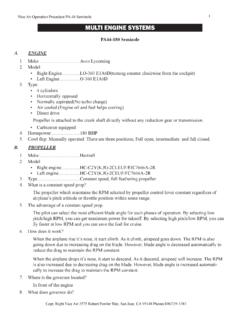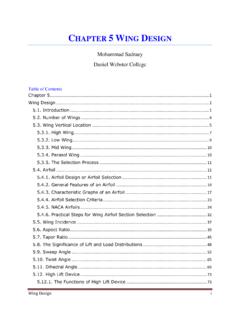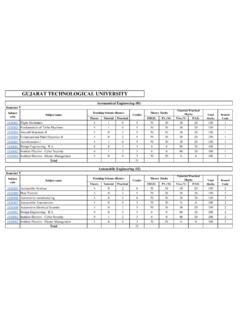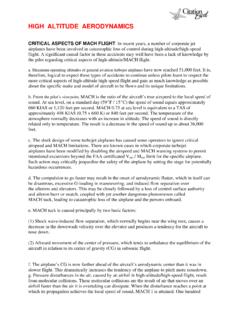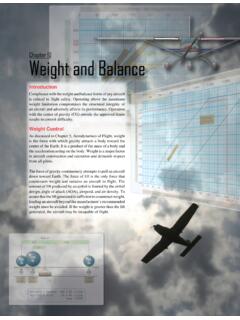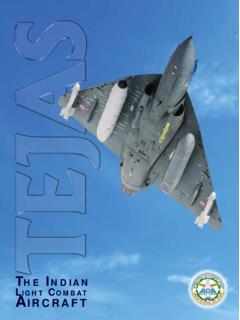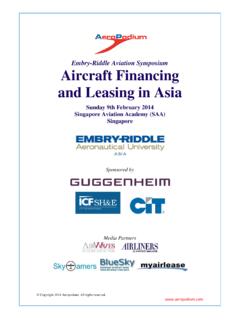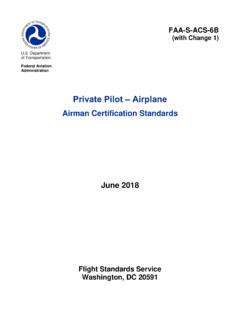Transcription of Multi Engine Rating Training Syllabus - Nice Air Aviation
1 Nice Air Multi Engine Training Syllabus1 Multi Engine RatingTraining SyllabusNice Air Multi Engine Training Syllabus2 Multi - Engine Rating Course Training SyllabusMULTI- Engine PILOT1. COURSE OBJECTIVESThe applicant will obtain the knowledge, skill, and aeronautical experience neces sary to meet the requirements for the addition of an airplane Multi Engine land class Rating to an existing pilot COURSE COMPLETION STANDARDSThe applicant will demonstrate through written tests and flight tests, and show through appropriate records that the knowledge, skill, and experience requirements have been obtained for the addition of an airplane Multi Engine land class Rating to an existing pilot GROUND Training COURSE OBJECTIVESThe applicant will acquire the necessary aeronautical knowledge for an airplane Multi Engine land class GROUND Training COURSE COMPLETION STANDARDSThe applicant will demonstrate, through oral and written tests and records.
2 That the necessary aeronautical knowledge has been obtained for an airplane Multi Engine land class FLIGHT Training COURSE OBJECTIVESThe applicant will obtain the aeronautical skill and experience necessary to meet the requirements for the addition of an airplane Multi Engine land class Rating to an existing pilot FLIGHT Training COURSE COMPLETION STANDARDSThe applicant will demonstrate through flight tests and school records that the aero nautical skill and experience necessary to obtain an airplane Multi Engine land class Rating have been COURSE ENROLLMENTTo enroll in the Multi Engine Rating course, the applicant must hold a valid private or commercial pilot certificate with an airplane category Rating and a single Engine land class Rating . A pilot must hold a valid third class medical certificate in order to obtain a Multi Engine Rating . However, pilots exercising the privileges of a com mercial Multi Engine Rating must hold a valid second class medical REQUIREMENTS FOR GRADUATIONTo obtain an airplane Multi Engine Rating limited to VFR only, the applicant must successfully complete all ground and flight lessons in Stages obtain an airplane Multi Engine Rating with instrument privileges, the applicant must successfully complete all ground and flight lessons in Stages I and obtain initial commercial pilot certificate with airplane category Multi Engine land class Rating , the applicant must successfully complete all ground and flight lessons in Stages I, II and LESSON DESCRIPTION AND STAGES OF TRAININGEach lesson is fully described within the Syllabus , including the objectives, stan dards, and measurable units of accomplishment and learning.
3 The stage objectives and stan dards are described at the beginning of each stage within the Air Multi Engine Training Syllabus3 CURRICULUM OVERVIEWGROUND Training SATGE As STAGE As STAGE As As FLIGHT TRAININGDUAL DUTY OF *Note: Flight Stage III is for Initial Commercial Pilot Certification Course Multi - Engine Class Rating Training SyllabusVideo, Class DiscussionBriefing/DebriefingGround Training TotalDay LocalDay Cross CountryNight LocalNight Cross CountryInstrumentDay LocalNight LocalCross CountryDual/Solo Combined TotalFLIGHT SATGE IFLIGHT STAGE IIFLIGHT STAGE III*Note: Flight Stage II is for the pilot who has instrument Rating in airplane single Engine . *Note: The pilot who doesn't have an instrument Rating should complete only Flight Stage I for additional Rating . *Note: The student who is seeking for initial commercial pilot certificate should complete all three stages to meet the flight experience requirements of part 61.
4 125 LESSON TIME ALLOCATIONG round TrainingFlight TrainingPilot briefingStage/Final examEx am debriefingDualDay localDay cross-countryNight localNight cross-countryInstrumentGROUND AND FLIGHT FL 2-Slow flight, stalls and steep GL 4- Engine out aerodynamics and operationsFL 3-Introduce single Engine FL 5- Engine out FL 6-Normal and crosswind takeoffs and FL 7-Short field takeoffs and FL 8-Single Engine landings, aborted GL 5-Operating on instrumentFL 9-Instrument FL 10-Single Engine instrument FL 11-Night FL 12-Day FL 13-Night FL 14-Long FL 15-Review, Preparation for Practical FAA Practical Test ( DPE) Stage Commercial pilot maneuvers , discussion, videoMulti Engine manual, class, discussion, videoGL 1-Exploring the ME Rating , Human factors and normal operationsGL 2-Aircraft systems, weight and balance and determining the performanceGL 3- Multi - Engine aerodynamics and maneuvers/proceduresFL 1-Introduction to Multi - Engine .
5 FL 4-Drag demo and Vmc demoAs Air Multi Engine Training Syllabus4 GROUND LESSON 1 1 HourExploring the Multi - Engine RatingA. LESSON REFERENCES: Multi - Engine MANUAL Chapter 1, Exploring the Multi Engine Rating , and Chapter 4, Performing Maneuvers and Procedures, Section A Normal Operations B. RECOMMENDED SEQUENCE:Lesson Introduction Class DiscussionC. OBJECTIVES: During this lesson, the applicant will become familiar with the Training pro gram and applicable regulations. The applicant will learn basic human factors concepts as they relate to Multi Engine operations, including high alti tude physiology. The applicant will be introduced to the Training airplane and to the procedures relating to normal operations in a Multi Engine airplane, including nor mal and short field takeoff and landing CONTENT:EXPLORING THE Multi - Engine RATINGSEEKING A NEW EXPERIENCE Why a Multi Engine Rating ?
6 The Training PathCONSIDERING HUMAN FACTORS Human Factors Concepts Are Two Engines Better Than One? Human Factors in Multi Engine Operations Aviation Physiology in Multi Engine AirplanesNORMAL OPERATIONS Using Checklists Preflight Inspection (Including the Minimum Equipment List) Ground Operations Starting Engines Taxiing Before Takeoff Check Takeoff and Climb Short Field Takeoff and Climb Cruising and Descent Planning Approach and Landing Short Field Approach and Landing Go AroundE. COMPLETION STANDARDS: During oral quizzing by the instructor, the applicant will demonstrate under standing of the Training program and the human factors issues related to Multi Engine operations. The applicant will exhibit knowledge of normal operating procedures by explaining elements selected by the instructor. The applicant will review the Summary Checklists and Key Terms for Chapter 1.
7 Sections A and B, and complete Exercise 4A with a minimum passing score of 80%. The instructor will review each incorrect response to ensure com plete understanding before progressing to Ground Lesson Air Multi Engine Training Syllabus5 GROUND LESSON 2 2:00 HoursUnderstanding Your Airplane Pilot s Operating Handbook (POH)A. REFERENCES: Multi - Engine MANUAL Chapter 2 B. RECOMMENDED SEQUENCE: Lesson Introduction Class DiscussionC. OBJECTIVES: The applicant will become familiar with the equipment and systems of the train ing airplane and learn how to compute and control the weight and balance. The applicant will also learn to accurately determine aircraft performance from Multi Engine airplane performance tables, charts, and/or CONTENT:EXAMINING SYSTEMSM ulti- Engine Powerplant Systems Fuel Metering Systems Ignition and Starting Systems Lubrication Systems Induction Systems Cooling and Exhaust Systems Engine Indicating SystemsEngine-Driven Power Systems Electrical Generating Systems Pneumatic Power Systems Hydraulic Power SystemsPropeller Systems Constant Speed Operations Power Control Propeller Synchronizing Feathering RestartingMulti- Engine Airframe Systems Electrical Distribution Hydraulic Systems Fuel Systems Landing Gear Systems Ice and Rain Control Systems Cabin Environmental SystemsCALCULATING WEIGHT AND BALANCE Weight Considerations Balance Considerations Weight Shifts and the Effect on Balance Differences in Weight and Balance Data for Multi EngineDETERMINING PERFORMANCE Performance Definitions The Single Engine Performance Penalty Using Performance Data V
8 Speeds Takeoff Performance Calculations Single Engine Rate of Climb Accelerate Stop Distance Accelerate Go Distance Climb Cruise Flight Single Engine Ceilings Descent Landing Performance Calculations Single Engine Go AroundE. COMPLETION STANDARDS: The applicant will exhibit knowledge of the systems of the Training airplane by explaining the operation of relevant systems. The applicant will demonstrate the ability to correctly compute the weight and balance for the Training airplane, including the expected performance based on at least two different loading conditions with the airport and envi ronmental conditions as specified by the instructor. The applicant will complete Exercises 2A, 2B, and 2C with a minimum pass ing score of 80%, and the instructor will review each incorrect response to ensure complete understanding before progressing to Ground Lesson Air Multi Engine Training Syllabus6 GROUND LESSON 3 1:00 HourIntroducing Multi - Engine Aerodynamics and ManeuversA.
9 REFERENCES: Multi - Engine MANUAL Chapter 3, Section A, Chapter 4, Section BB. RECOMMENDED SEQUENCE: Lesson Introduction Class DiscussionC. OBJECTIVES: During this lesson, the applicant will learn the fundamentals of Multi Engine aerodynamics and the elements of the specified Multi Engine maneuvers. The applicant will also develop stall/spin awareness and a clear under standing of the elements relating to stalls and spins in Multi Engine air CONTENT:DISCOVERING AERODYNAMICSMULTI- Engine AERODYNAMICS Boundary Layer Effect Induced Flow Turning Tendencies High Speed FlightPERFORMING MANEUVERS AND PROCEDURES MANEUVERS Steep Turns Slow Flight Stalls (Power On and Power Off ) Spin Awareness Emergency DescentE. COMPLETION STANDARDS: The applicant will demonstrate knowl edge of Multi Engine aerodynamics by explaining elements selected by the instructor during oral quizzing.
10 The applicant will demonstrate knowl edge of the required maneuvers by explaining the elements relating to each maneuver. The applicant will demonstrate knowl edge of stalls and spins in Multi Engine airplanes by explaining the aerodynam ic conditions required for a spin, the flight situations and conditions where unintentional spins may occur. The instrument indications during a spin and/or spiral, and the techniques and procedures used to recognize and recover from unintentional spins. The applicant will complete Exercises 3A and 4B with a minimum passing score of 80%, and the instructor will review each incorrect response to ensure complete understanding before progressing to Ground Lesson Air Multi Engine Training Syllabus7 GROUND LESSON 4 2:00 HoursSingle Engine OperationsA. REFERENCES: Multi - Engine MANUAL Chapter 3, Section B, Chapter 5, Section A,B and D Pilot's Operating Handbook (POH)B.

